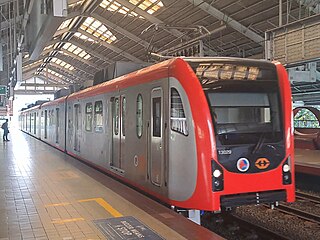
The Manila Light Rail Transit System, commonly known as the LRT, is an urban rail transit system that primarily serves Metro Manila, Philippines. Although categorized as a light rail system because it originally used light rail vehicles, it presently has characteristics of a rapid transit system, such as high passenger throughput, exclusive right-of-way, and later use of full metro rolling stock. The LRT is jointly-operated by the Light Rail Transit Authority (LRTA), a government corporation attached to the Department of Transportation (DOTr), and the Light Rail Manila Corporation (LRMC). Along with the Manila Metro Rail Transit System and the Metro Commuter Line of the Philippine National Railways, the system makes up Metro Manila's rail infrastructure.

The Metro Rail Transit Line 3, also known as the MRT Line 3, MRT-3 or Metrostar Express, is a light rapid transit system line of Metro Manila, Philippines. Originally referred to as the Blue Line, MRT Line 3 was reclassified to be the Yellow Line in 2012. The line runs in an orbital north to south route following the alignment of Epifanio de los Santos Avenue (EDSA). Although it has some characteristics of light rail, such as the type of a tram-like rolling stock used, it is more akin to a rapid transit system owing to its total grade separation and high passenger throughput.
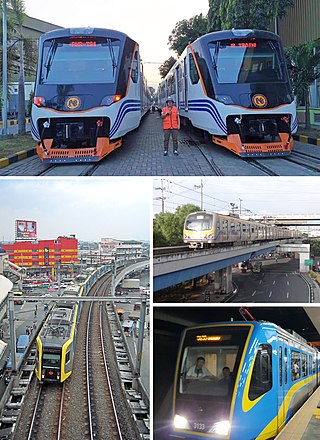
Rail transportation in the Philippines is currently used mostly to transport passengers within Metro Manila and provinces of Laguna and Quezon, as well as a commuter service in the Bicol Region. Freight transport services once operated in the country, but these services were halted. However, there are plans to restore old freight services and build new lines. From a peak of 1,100 kilometers (680 mi), the country currently has a railway footprint of 533.14 kilometers (331.28 mi), of which only 129.85 kilometers (80.69 mi) are operational as of 2024, including all the urban rail lines. World War II, natural calamities, underspending, and neglect have all contributed to the decline of the Philippine railway network. In the 2019 Global Competitiveness Report, the Philippines has the lowest efficiency score among other Asian countries in terms of efficiency of train services, receiving a score of 2.4, and ranking 86th out of 101 countries globally. The government is currently expanding the railway network up to 1,900 kilometers (1,200 mi) by 2022 through numerous projects.

The Light Rail Transit Line 1, commonly referred to as LRT Line 1 or LRT-1, is a light rapid transit system line in Metro Manila, Philippines, operated by Light Rail Manila Corporation (LRMC) and owned by the Light Rail Transit Authority (LRTA) as part of the Manila Light Rail Transit System. Originally referred to as Metrorail and the Yellow Line, LRT Line 1 was reclassified to be the Green Line in 2012. It travels in a general north–south direction from Baclaran to Monumento, and then east–west from Monumento to Fernando Poe Jr. Currently, the line consists of 20 stations and runs on 19.65 kilometers of fully elevated route. Although it has the characteristics of light rail, such as with the type of rolling stock used, it is more akin to a rapid transit system owing to its total grade separation and high passenger throughput.

The Light Rail Transit Line 2, also known as LRT Line 2,LRT-2 or Megatren, is a heavy rail rapid transit line in Metro Manila in the Philippines, generally running in an east–west direction along the Radial Road 6 and a portion of the Circumferential Road 1, referred to as the Purple Line, and previously known as the Mass Rapid Transit Line 2 or MRT Line 2 (MRT-2).
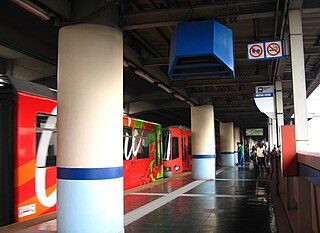
North Avenue station is an elevated Metro Rail Transit (MRT) station located on the MRT Line 3 (MRT-3) system in Diliman, Quezon City. It is named after its location, which is at the corner of Epifanio de los Santos Avenue (EDSA) and North Avenue, it is the current northern terminus of the line.

The Metro Rail Transit Corporation (MRTC), is a private consortium organized in June 1995. The consortium is composed of seven (7) Filipino-owned companies: Fil-Estate Management Inc, Ayala Land Inc, Ramcar Inc, Greenfield Development Corporation of Unilab, Anglo-Philippine Holdings Corporation, National Book Store Group, Allante Realty and Development Inc, and DBH Inc. The Metro Rail Transit Corporation owns the Manila Metro Rail Transit System Line 3 running along the EDSA corridor. MRTC was the original contractor for the EDSA MRT-3 Project. It runs the MRT-3 in coordination with the Department of Transportation under a 25-year Build-Lease-Transfer contract or BLT Agreement, which will end in 2025.
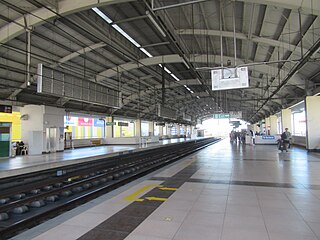
Fernando Poe Jr. station is the current northern terminus of the Light Rail Transit Line 1 (LRT-1) system. It opened on October 22, 2010, as part of the LRT-1 North Extension Project, as Roosevelt and was renamed to its current name on August 20, 2023, almost two years after the namesake avenue was officially renamed after the Filipino actor.

The North Triangle Common Station, popularly known as the Common Station, is an under-construction rapid transit terminal and transport hub that will connect LRT Line 1, MRT Line 3, and MRT Line 7, and the nearby Metro Manila Subway. It is located in Bagong Pag-asa, Quezon City, Philippines, and is named after its location, which is at the corner of EDSA and North Avenue.

Batasan station is an under-construction Metro Rail Transit (MRT) station located on the MRT Line 7 (MRT-7) system in Batasan Hills, Quezon City, Philippines. It is near the Sandiganbayan Centennial Building, Public Attorneys Office Building, Batasan TODA Terminal, the Commission on Audit Complex and the Batasan Pambansa Complex. It is the ninth station for trains headed towards the North Triangle Common Station and the sixth station for trains headed to San Jose del Monte.
Quezon Memorial Circle station is an under-construction Metro Rail Transit (MRT) station located on the MRT Line 7 (MRT-7) and the proposed MRT Line 8 (MRT-8) systems within the Quezon Memorial Circle, Quezon City.

The transportation system in Metro Manila covers the road network, rail network, ferries, ports and airports located with the metropolitan Manila area. Road transportation in Metro Manila is diverse, composed of many types of private and public transport vehicles. These include Taxis, buses, jeepneys, tricycles and pedicabs. In some areas, especially in Divisoria and large public markets, two-stroke motors are fitted in the pedicabs and are used for goods transport. Regardless of modernity, horse-drawn kalesas are still used in the streets of Binondo and Intramuros. Ridesharing services such as Grab also operate within in Metro Manila.

The Manila Metro Rail Transit System (MRTS), commonly known as the MRT, is a rapid transit system that primarily serves Metro Manila, Philippines. Along with the Manila Light Rail Transit System and the Metro Commuter Line of the Philippine National Railways, the system makes up Metro Manila's rail infrastructure.
The Metro Rail Transit Line 4 (MRT-4) is an upcoming rapid transit line serving the Greater Manila Area of the Philippines. The 12.7 km (7.9 mi), 10-station elevated railway will connect Ortigas Center in Metro Manila and the suburban municipality of Taytay, Rizal. It will traverse along Ortigas Avenue and Manila East Road, starting at the former's junction with EDSA in Quezon City to the west until it terminates near the New Taytay Public Market to the east.

The MRTC 3000 class or ČKD Tatra RT8D5M LRV, also known as Tatra Train, is a class of high-floor light rail vehicles built by Czech tram manufacturer ČKD Tatra. It is currently used on the Manila MRT Line 3 and were the last vehicles made by ČKD Tatra before it was taken over by Siemens.
The Metro Manila Subway, formerly known as the Mega Manila Subway (MMS), is an under-construction underground rapid transit line in Metro Manila, Philippines. The 36-kilometer (22 mi) line, which will run north–south between Valenzuela, Quezon City, Pasig, Taguig, Parañaque and Pasay, consists of 15 stations between the East Valenzuela and Bicutan stations. It will become the country's second direct airport rail link after the North–South Commuter Railway, with a branch line to Ninoy Aquino International Airport.
New Manila International Airport, also known as Bulacan International Airport, is an international airport under construction on the coastal areas of Bulakan, Bulacan, 35 km (22 mi) north of the capital Manila. The project was proposed by the San Miguel Corporation (SMC) and is set to help decongest Ninoy Aquino International Airport (NAIA), the main gateway to the capital for air travelers.
National Route 170 (N170) is a national secondary road of the Philippine highway network. It passes through the northern part of Metro Manila, traversing through the cities of Quezon City, Manila, and Pasay.

Rail transportation in the Greater Manila Area is a major part of the transportation system in Metro Manila and its surrounding areas. It consists of the Manila Light Rail Transit System, Manila Metro Rail Transit System, and the PNR Metro Commuter Line. The network makes up the majority of active railways in the country and bear the brunt of providing the metropolis with rail as a faster alternative mode of transport other than buses and jeepneys. However, these systems are currently insufficient for the rapidly expanding metropolis; to address this, new lines and line extensions are under construction, which will extend the system far out into neighboring regions.
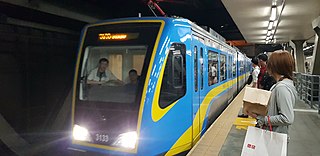
The MRTC 3100 class or CRRC Dalian 8MLB LRV, commonly called as the Dalian Train, is the class of second-generation uni-directional light rail vehicles built in China by CNR Dalian, now CRRC Dalian. Since its delivery, most of the trains are still being tested and undergoing final assessments, before being used on regular services on Line 3 of the Manila Metro Rail Transit System.




















